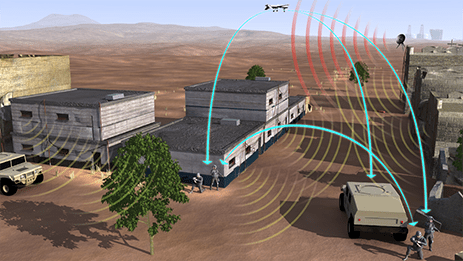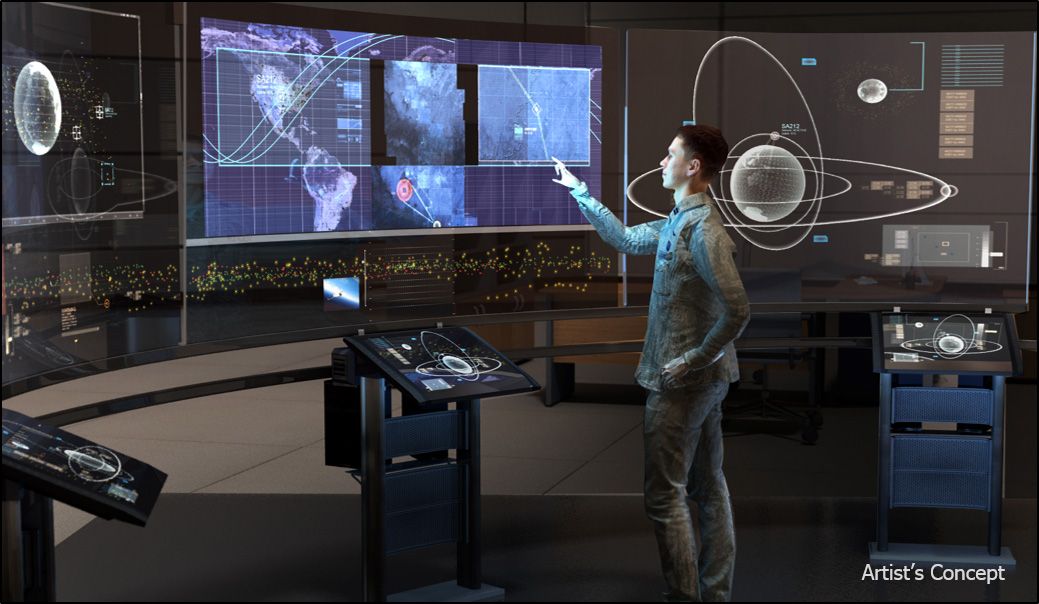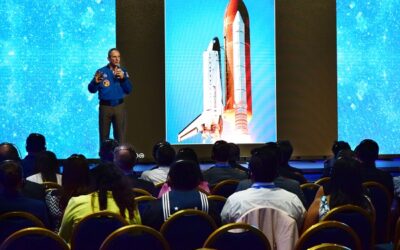Fusing and Communicating a Common Operating Picture at the Speed of Light
Imagine the power of a fully integrated, redundant, resilient and networked fighting force that operates in the multi-domain battlespace. This vision is held by many in the US military and is highlighted by the new aphorism: “No platform fights alone.” Today, with the Internet of Things (IoT) looming on the commercial horizon, it becomes easier to visualise a military IoT in which most key battle systems are connected in a knowledge network. Just as the world was transformed by the mobile smartphone revolution in a very short time, the introduction of the IoT will be a major shift towards a stacked (or honeycombed) “software-based ecosystem of things,” involving user interfaces (UI), applications, essaging/communication, data and infrastructure. Cheap sensors will allow new systems to communicate with each other and to upgrade older systems in order to join the network. The US military sees the potential of this shift and is slowly evolving revolutionary C5ISR systems and processes to eventually integrate all systems into an enhanced, honeycombed C5ISR structure. How long will this take and what is being done today? Let’s explore this and project what might be in play in ten or fifteen years.
C5ISR stands for Command, Control, Communication, Computer, Combat Systems, Intelligence, Surveillance and Reconnaissance, but the new big dog in the fight is the threat and promise of cyber war and the impact of intelligent machines. According to a recent study by Martti Lehto at the 11th International Conference of Cyber Warfare and Security, “a real time situational picture and shared situational awareness must be achieved ever more rapidly… The present warfare is totally dependent on the C5ISR system… the C5ISR system is the most vulnerable part and therefore it has to be the most important object of the cyber defence of the armed forces.”
The need for military decision-makers to visualise the ever-complex multi-domain battlespace is pressing. US military analysts Robbin F. Laird, Edward Timberlake and Richard Weitz recognised this back in 2013 when they published a paper titled ‘Rebuilding American Military Power in the Pacific: A 21st-Century Strategy.’ In this study they stated: “For the United States to have an effective military role in the new setting of regional networking, a key requirement will be effective and assured combined command, control, and communications, linked by advanced computing capabilities to global, regional, and local intelligence, reconnaissance, and surveillance assets (C5ISR). The services will need to ensure that there is a broad synergy among US global forces, fully exploiting new military technologies and the more modest capabilities of regional allies and partners. Indeed, C5ISR is evolving to become C5ISR-D (for decision), whereby the purpose of C5ISR is to shape effective, combined and joint decision making.”
The authors view decision-making as the key element. They see each military platform as a source of information that can interact in a knowledge network and enhance a distributed force’s capability to operate as a honeycomb to extract maximum utility from the entire force. This stacked, or honeycombed knowledge network, with every system interacting to pass information, could provide decision-makers with the capacity and capability to understand and engage the enemy as never before.
All systems will play a part in this network as new systems are fielded and legacy systems are upgraded. The most striking example of a new system is how a group of Lockheed Martin F-35 LIGHTNING IIs will be able to share a fused information display with other air systems, UAVs, ground systems, robotic systems, submarines, surface ships and satellites operating in the battlespace. “The F35 will be a ‘first-generation flying combat system’ that will enable air-ground communication and ISR exchanges unprecedented in military history,” according to the study cited above. “The pilot will be a full member of the ground team; the ground commanders will have ears and eyes able to operate in a wide swath of three-dimensional space.”
Such interactivity requires improved computing power, as future wars will be fought on computer networks as much as with kinetic strikes. These networks are improving dramatically and increasingly operate at faster speeds. In the past, the human operator controlled the action. Half of all human brainpower is involved in visual processing. Humans use this incredible visual processing power to recognise patterns. In a firefight, a combat leader needs to recognise a myriad of patterns – the enemy’s capabilities, possible actions and reactions – to be able to decide and act in a matter of nanoseconds, or be outthought and killed by his enemy. Recognising the patterns of war has been the supreme skill of the winning strategist. But as amazing as humans are at pattern-recognition decision-making, machines are catching up, and very soon we will only be able to stay engaged in the decision-making process if we can see the unseeable.
Today, the human operator is “in the loop” for most semi-autonomous systems. With the emergence of a new breed of autonomous systems, particularly missile and unmanned combat air systems, however, this “man in the loop” concept is becoming increasing ineffective. Future unmanned systems will act in micro- or nano-seconds and may be programmed and optimised with policy and legal constraints that will not require human decision-making or input. These systems will operate so rapidly that human decision-making will slow and defeat the process. Instead of the human operator “in the loop,” the man will be “on the loop,” observing and acting by exception only. One of the key requirements to retain human control “on the loop” is an effective UI, or Common Operating Picture (COP), that is communicated in real-time or, more effectively, at the speed of light.

One way to improve the input of vital situational awareness information that is needed to form an effective C5ISR-D COP is to digitise older, analog military ISR sensors such as radars and electronic warfare (EW) systems. One recent DARPA-funded advance, an exceptionally high-speed analog-to-digital converter (ADC), represents a major step forward. The new ADC samples and digitises spectrum signals at a rate of over 60 billion times per second (60 GigaSamples/sec). This process, in essence, brings the IoT to the battlespace, allowing machines to talk to machines at an extremely fast speed to enhance situational awareness. With the advances and miniaturisation of computers and communications, legacy ground systems could also be upgraded to join this knowledge network. Imagine if the internal legacy systems of the US Army’s M1A2 ABRAMS Tank, some dating back to the 1970s, were replaced with the latest electronics, communications and computers with the goal of interconnecting every tank with all other connected platforms into a modern multi-dimensional battlespace? In this case, each tank becomes a C5ISR-D node, like the F-35. Tactical systems in all domains could now become nodes of the knowledge network and their redundancy can provide resilience.
In August 2016, Raytheon took a step forward in the visualisation of integrated systems with its version of an EW-Cyber COP management tool at the US Army’s “Cyber Quest” exercise. Raytheon’s Cyber and Electromagnetic Battle Management (CEMBM) system is designed to provide shared situational awareness of electronic warfare and cyber systems in the battlespace. Frank Pietryka, director, Airborne Information Operations at Raytheon Space and Airborne Systems explained: “With CEMBM, teams now have a common operational picture where they can move back and forth, at will, between cyber, EMS and physical terrains. It is a true game changer.”
This is an important step in visualising the unseeable, but there is still a long way to go before all battle systems are integrated into a single C5ISR-D COP to assist military decision-makers in recognising the patterns of a multi-domain battlespace and reacting in time. All domains must be integrated and visualised in real-time — a complex and difficult task that will require dedicated and focussed systems development.
A similar effort to integrate communications and visualise ground, air and space systems is underway in DARPA’s Hallmark programme. Hallmark is an effort to develop situational awareness tools to integrate space systems within the knowledge honeycomb. The programme goal is to deliver a real-time COP of space-domain systems, “as well as external interfaces to air, cyber, land, maritime, and command and control environments,” according to an article written for DARPA by Lieutenant Colonel Jeremy Raley, USAF, PhD. “DARPA’s Hallmark programme seeks to provide a full spectrum of breakthrough real-time space-domain systems and capabilities to help address these technical and strategic challenges. The envisioned system would fuse information from diverse sources, allow potential actions to be simulated and effects determined in advance, and vastly reduce the overall time required to make and execute decisions and observe results.”
On the farther horizon are even more exotic ways to gain a level of unparalleled situational awareness by bridging the divide between human and machine. A new DARPA programme, Neural Engineering System Design, aims to develop an implantable neural interface able to provide unprecedented signal resolution and data-transfer bandwidth between the human brain and the digital world. “Today’s best brain-computer interface systems are like two supercomputers trying to talk to each other using an old 300-baud modem,” said DARPA’s Neural Engineering System Design programme manager, Phillip Alvelda. “Imagine what will become possible when we upgrade our tools to really open the channel between the human brain and modern electronics.”
The scenario in which a battlefield commander received hour-long decision briefings from a group of dedicated staff officers is now anachronistic. The speed with which decisions and actions must occur on today’s multi-domain battlespace may increasingly exceed human cognitive capacity and already requires automated assistance. Visualising the unseeable, like the virtual world of cyberspace operations, and connecting the physical and virtual battlespace to provide actionable information, requires extraordinary technology and the connection of a honeycomb of sensors, transmitters and platforms. In today’s battlespace, military decision-makers must see the full pattern of enemy activity, in the physical and virtual battlespace, and must then rapidly reach a decision and apply counter-patterns in time. With autonomous machines acting and deciding in nanoseconds, weapons employing swarm technology and multiple cyber attacks happening in real-time, the need for a light-speed C5ISR-D COP to visualise a shared situational awareness of the entire battlespace is a key ingredient to fully exploit emerging military technologies.
John Antal
For more information please see MILITARY TECHNOLOGY #5/2017 and WEHRTECHNIK #II/2017, available on stand #F-57 at the show; and frequently check back for more NEWS FROM THE FLOOR.

























